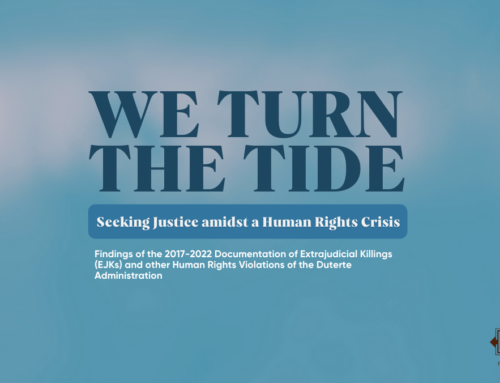Text by Luis Abesamis and Marianne Ignacio
Photographs by Joaquin Reyes
Like many barangays in Navotas, Barangay Tanza 2 faces the sea. Breeze from the waters is scarce, and when it arrives, it is often too warm to be refreshing. While jumping into the sea for a midday swim is tempting, the aggregation of garbage occupying nearly every inch of the waters enclosing the seawall discourages such a thought.
Created under Republic Act 10935 signed by President Rodrigo Duterte in 2017, Tanza 2 is a product of a division of what was Barangay Tanza into two distinct and independent barangays. The community is home to hundreds of families whose lives were changed after Typhoon ‘Pedring’ devastated Luzon in 2011. After years of living in evacuation centers across Navotas, the affected families were given an opportunity to move into a permanent housing facility.
Today, rows upon rows of identical red-roofed small houses are painted with bright hues of blue and yellow. Many houses remain festooned with campaign posters and tarpaulins, barking out the names and faces of politicians who ran during last May’s elections. On the streets, groups of children run around and play, their laughter ringing out and overpowering the din of housework from within their homes.
Built upon reclaimed soil, this community of socialized housing units in Tanza 2 was developed through the efforts of the city government working with Habitat for Humanity, the National Housing Authority and the Philippine Congress. Because it stands below sea level, flooding in the community is routine. Wide, murky pools of water form minutes after rainfall, or when the tide comes in. Trash along the seawall is mirrored in street corners and sidewalks.

Barangay Tanza 2 is a relocation site for families affected by Bagyong Pedring. Children create playgrounds out of these cemented roads which still get flooded, especially during typhoon season.
The health risks posed by the combination of regular flooding and the overflow of garbage cannot be diminished. Swarms of flies threaten illness, while the prevalence of skin diseases among children signal intense health risks. Worryingly, the community lacks a functional health center.
The housing administration, however, is currently building a new health center in response. That, alongside a new basketball court, form an array of facilities made available for the benefit of the community. These facilities include a multi-purpose hall for events, a small market that sells basic goods, and a playground for children. In return, each family must pay a maintenance fee of Php 300 each month. For others, this may be a small amount in return for the regular upkeep and upgrading of community houses and facilities, but meeting these monthly payments remain a challenge.
Because these conditions impact the lives and well-being of children, they need to be surfaced and examined through the lens of the United Nations Convention on the Rights of the Child (UNCRC), the fundamental measure that sets out children’s rights. Countries who have agreed to the convention—the Philippines, among them—are legally bound to the standards and protocols that respect, protect, and fulfill children’s rights. The Convention contains 54 articles that cover the definition of a child, fundamental children’s rights, and the measures that governments can implement to make the exercise and enjoyment of these rights as the norm for all children.

Jhepoy(not his real name) is a 10 year-old boy who collects garbage for money. Many children his age engage in child labor due to extreme poverty.
Unfortunately, the burden of overcoming the difficult conditions of life in Tanza 2 is often taken up by children as well. At a very young age, many children in the community realize the need to help their parents by pursuing paying jobs. Some want to balance their roles as students and as co-providers, earning their share of the family income. Others forego their studies so they can fully commit to working.
We spent an afternoon with some of Tanza 2’s child workers. Within their stories, we uncover the pressing reality of child labor and how it has become normalized in communities such as Tanza 2.
The siblings agree that not selling all of their fish for the day is a serious problem. One consequence is that out of the three siblings, only one may be able to go to school.
Joanna, Randy and Raymond
Nine-year-old Joanna and her older brothers Randy (age 12) and Raymond (age 10) work as fish vendors. For a year now, the siblings peddle fish door-to-door every day before school. While they have four other brothers and sisters, they are primarily the ones who sell the fish their mother fixes for them. “Kapag meron pong hinahandang isda si mama, tinitinda po namin,” says Randy.
In the mornings, the siblings work together to cover all the blocks in the community. As the eldest in the group, Randy holds two plates while Joanna and Raymond each carry one. As soon as their fish plates are empty, they run back home to refill them and continue on until all the fish they need to sell are gone.
The siblings agree that not selling all of their fish for the day is a serious problem. One consequence is that out of the three siblings, only one may be able to go to school. The other two would need to stay at home because they do not have money for baon and pamasahe.
Their vending goes against Tanza 2’s policy of prohibiting residents from selling goods or offering services, since the area is marked as strictly residential only. Joanna describes a recent encounter with local barangay officials which left her traumatized. As Joanna tells it, one official forced his entry into their home and used the barangay’s dog to threaten their mother. “Nakita po kasi nila naglalako si mama. Nahimatay nga po si mama noon,” says Joanna. She elaborates further and recalls seeing her mother shield her and her twin brother from the dog; “Si mama po ‘yung yumakap, umiiyak po kami noon.” Palpable in her telling is the distress that she felt. And strange as it seems to hear a nine-year-old comprehending the concept of trespassing, she also points out the official’s actions saying, “’Yung paa niya po, gumanon sa may bahay namin. Tresspassing na po ‘yun.”
Article 19 of the United Nations Convention on the Rights of the Child (UNCRC)—to which the Philippines is a State Party —states that children must be protected from all forms of violence, both mental and physical. For Joanna to witness her mother’s struggle with State agents is highly irregular, and has resulted in trauma.
Despite the existing threat of reprimand from the authorities, Joanna and her siblings continue on, as they cannot pass up the opportunity to earn additional income. The area’s market, supposedly an area for residents to sell and trade goods, has upfront costs that families like that of Joanna’s cannot afford. The daily rent payments for a market stall is also too high of a risk if the day’s sales are not enough. The only way for any stall vendor to break even is to pass these costs on their goods, which would make them too expensive for many of the residents to afford. As it stands, business in the market is noticeably muted.
To the extent that Joanna, Randy, and Raymond all have had to contribute to the family income, in ways that expose them to possible repercussions from the barangay, there is no sense that the siblings were forced to work by their parents. The culture of child labor is normalized in the community that the siblings, along with many other children in the area, have internalized a sense of obligation to work to augment their family’s income. The concept of child labor is understood less as a negative and more as an imperative given their circumstances.
This flows naturally with the discourse of child rights, in that assumptions exist about how children are exploited by the adults around them, given their vulnerable nature. This is definitely the case for a lot of child workers, but for the children we talked to, there is an ownership to the decision to work, an exercise of their agency at a young age.

Children from the community go to school either from morning to afternoon or afternoon to evening. This gives them plenty of time to supplement their family’s income by working.
The reality of growing up in Tanza 2 is that children already see themselves as active participants in fulfilling the needs of the family. When asked where their earnings go, Randy says, “Kay mama po lahat napupunta, binibigyan na lang po niya ako ng bente.” Mitoy, whose story we will share below, also agrees.
There is pride in the way they say these words. Dianne, who works while also being busy in school, explains, “Sinabay ko na lang po ‘yung pag-aaral ko po sa pag-tinda, para bawas gastos po si mama para sa’kin.”
If we are to talk of blame, the issue goes beyond the limitations of parents as providers. One must also recognize the systemic issues at play in shaping their concept of working as children. The impetus for work is a direct response to the conditions created and cultivated by the lack of employment opportunities, the presence of programs and policies with a misguided sense of the community’s best interests, and the continuing neglect of officials at the local and national levels. More than that, we need to realize the influence of these interrelated and overlapping conditions in the understanding of child laborers and their families about their human rights.
Mitoy and Kaloy
Mitoy is 12 years old and the second out of six siblings. He loves wrestling with his friends and riding the seesaw in the playground. Kaloy is 14, the eldest among six children. He likes to be on Facebook and occasionally plays basketball with his friends in the community’s court. Mitoy and Kaloy both ride boats and work the docks to catch seafood to sell in the local market.
As young as they are, both are already well-versed in the fishing trade. Even before Mitoy started working on the boats, he had learned about fishing by watching from the sidelines. At 14, Kaloy has more work experience. Nonetheless, they have similar roles and responsibilities at work. Mitoy is responsible for setting up the nets. “Ilalatag lang po, tapos papa-andarin ‘yung bangka, tapos hahawakan po namin ‘yung mga pano, ta’s sampung arya,” explains Mitoy. But what if there is no catch? “’Pag walang huli, tinatanggal na lang po namin sa laot ang fishnet.”
Despite their years of experience, both have never been given any formal training on the most basic way to survive in the water. Kaloy learned how to swim because his cousin taught him while Mitoy learned from his father.
Working the boats means waking up early in the morning. Throughout the day, they are exposed to the sun as they pull fishing nets larger than their bodies. When asked what protects them from the heat of the sun, Mitoy said that they only wear a sando and parakyu, a type of quick-dry pants.
The fishing nets require attention as they often tangle together. This means diving and navigating the waters. They repeat this process constantly throughout the day to maximize the catch. They also circle the sea wall thrice to ensure they have covered every area. Depending on the current and the amount of fish they catch in every turn, work days can last until late in the afternoon and sometimes extend until the next day.
At the end of every shift, Mitoy can bring home Php 350 for his family. Kaloy can earn as much as Php 1,000 a day by working during the weekends. However, income fluctuates depending on the amount of fish that they catch. Additionally, despite the same amount of effort, factors such as unpredictable weather conditions, changes in the tides, and the volume of other fishing boats in the area influence how much money they can take home.
Aside from the unstable income, this kind of work exposes the children to dangerous situations. As young as they are, they are expected to work long hours like their adult counterparts. Depending on the schedule, they also go to school before or after work. At their homes, both help out with chores and with taking care of their younger siblings. They are, simultaneously, sons, older brothers, fishermen, and students.
Kaloy understands the perils that come with his job. “Hindi po ligtas. Malalaki po ‘yung alon, ‘pag madilim, baka po may mabangga.” He also remembers one accident that happened to his co-workers: “’Nung naputol ‘yung katig, lumubog sila.” Despite these very real risks, there are no life jackets or first aid kits available to them.
This kind of work environment directly contradicts Article 32 of the UNCRC, which states that children must be protected from exploitative work that is harmful or might get in the way of good health or education.
Dianne
Dianne is 17-years-old and the second youngest out of five children. Her three older siblings all have their own families, while her and the youngest remain with their parents at home. She recently graduated from the Alternative Learning System (ALS) curriculum and is now about to enter college. Like Kaloy, Dianne loves being on Facebook. She is also extremely passionate about cooking. She plans to take up culinary arts and dreams of becoming a chef someday and putting up her own restaurant.
When she is not busy with school work, Dianne works as an all-around bantay of a CD store at the nearby local mall. She works longer hours compared to a regular employee; her shift starts at 9 in the morning and ends 12 hours later, with only two 30-minute breaks throughout. Dianne mostly works alone, in multiple roles as the cashier, salesperson, security, and stocker. The owner only helps out when lines get considerably longer. “’Pag sunod-sunod po ‘yung tao, siyempre ako lang, nakakataranta din at nakakapagod.”
Adults might say that children ought to be given responsibilities early to train them for adult life. But Dianne’s working conditions have become physically and emotionally taxing. She says that the exhaustion she feels on a daily basis has affected her wellbeing, given that she works from Monday to Saturday. As for her employer’s treatment, “OK naman po, hindi naman po siya mahigpit. Kunwari po ‘pag walang customer, hinahayaan niya po ako mag-cellphone.” Considering her disposition, Dianne views this as a “bonus.”
With only an hour’s worth of breaks in a work day, Dianne is intensely overworked. When compared to the P512 minimum wage in the National Capital Region, Dianne is also underpaid at a fixed P250 a day. She also does not receive overtime pay, despite her 12-hour work days. Just as an employee, the terms of her working conditions are illegitimate by law. As a child, she also has limited information and understanding of her rights. At work, Dianne is unable to negotiate her working hours, salary, and amount of responsibilities.
Her working conditions are disadvantageous for her as studies have proven that rest, play, and other types of leisure activities are essential for children because it contributes to their “cognitive, physical, social, and emotional well-being.” Article 31 of the UNCRC also states that working early may harm a child’s physical and mental development, as it takes away opportunities to relax and play.
In an environment like Tanza 2, where the culture of child labor is normalized, children often grow up conforming to the expectation of working young to help their families.
The role of the State
Breadwinners in Tanza 2 are fisherfolk, construction workers, factory workers, and vendors. Income is not stable; fisherfolk rely on their catch of the day while workers are employed on a contractual basis.
Living expenses also disproportionately go to commuting costs. The prevalence of tricycles in the community indicate the distance of many basic services. The schools, markets, and health centers are situated more than a kilometer away. With tricycle fare at P15 per person, some adults and schoolchildren prefer to walk, braving the often-scorching heat and humidity.
Despite these conditions, the residents of Tanza 2 continue on. They have to. Work is high priority, because should they fail to pay the maintenance fee for two consecutive months, their electricity gets cut off. If fisherfolk are unable to sell enough of their catch, the rest of the family will have to adjust. Children who cannot afford tricycle rides must choose between walking to school or staying at home and missing the day’s lessons. For Dianne and many of her peers, the choice is clear: they need to work.
But their stories highlight the unfortunate reality that most of these informal jobs, often physically and emotionally demanding, are harmful to children’s well-being. At their age, it can be difficult for them to negotiate terms of their employment in order to mitigate their disadvantages.
By law, the employment of children is highly regulated. Republic Act No. 7610, also known as the Special Protection of Children Against Abuse, Exploitation, and Discrimination Act, recognizes that there are forms of child labor that may lead to irreversible repercussions. There is also Presidential Decree No. 603, or the Child and Youth Welfare Code, which explicitly states that every Filipino child has the right to be protected from all forms of hazards, exploitation, and other circumstances that harm their overall development.
The Situation Analysis of Children in the Philippines, conducted in 2018 by the Philippine government and the United Nations Children’s Fund (UNICEF), reported that Filipino children deep in poverty face structural barriers that prevent the full realization of their rights. Deprived of their basic needs such as food, shelter, and education, outcomes such as long-term well-being and development are negatively influenced. Because of immense and systemic barriers, not all children are guaranteed lives of dignity and security that they inherently deserve. That is why safeguards are important in acknowledging the inherent rights of children.
Hence, the UNCRC. The Philippines, in fact, is one of the first to become a State party to the Convention, having ratified it in 1990. As a State Party, the Philippines is duty-bound to create and enforce laws that reflect the terms of the Convention.
To that end, the Philippines has no shortage of laws that are intended towards the welfare and safety of children in the country. What is immensely lacking, however, is effective implementation. As well, government policies that are anti-poor, such as the TRAIN laws, have a profound effect on the living conditions of poor families and their children, which drives more children to child labor.
Advocating for children also means recognizing that parents, caretakers, and all adult members of the community are duty bearers, with obligations in ensuring that all children enjoy and realize their rights. In an environment like Tanza 2, where the culture of child labor is normalized, children often grow up conforming to the expectation of working young to help their families. Parents and caretakers may also find difficulty in distinguishing the difference between what is best for the family and what is in the best interests of their children.
We need to assert the obligation of the State to uphold and secure children’s rights. Article 4 of the UNCRC calls upon governments to take full responsibility in making sure that “children’s rights are respected, protected, and fulfilled.” Demanding from our leaders is not only our right, but our duty as well. We need to call out incompetence where it exists and challenge their policies and programs that do not have the best interests of children in mind.

We must unlearn our misconceptions about child labor. As we listen to the stories of these children, we give them a platform to participate in creating a better life for themselves.
Looking at child labor through children’s eyes
It is easy to fall into the temptation of thinking that these children have a similar understanding of child labor as the rest of us. That walking around selling fish, hauling fish nets in poorly equipped boats, and working 12-hour shifts at the mall have made them realize that their rights are being violated. But the truth is as simple as it is painful: they want to help their families.
Although these children may work as a response to their conditions, they also work despite them. Their motivation to work comes from a desire to help carry the burden of providing for their family. That, to them, may be empowering. And the strength they draw from these circumstances has helped them continue to dream and pursue a life beyond the realities of Tanza 2.
Watching Cardo Dalisay on television has inspired Kaloy to become a soldier someday. Raymond, on the other hand, hopes to become a firefighter to help people, inspired by the service of firefighters in their community. Randy’s creative mind has helped him dream of becoming a fashion designer and bring his gown designs to life someday. Dianne’s love for her mom’s cooking has helped her fuel her dream of becoming a chef and starting her own restaurant in the future.
These dreams are as real as their difficult circumstances. That these dreams may have been shaped by life in Tanza 2, including their experiences working at a young age, highlights the importance of the family (parents and adult relatives), the school (teachers and administrators), the community (local institutions), and the State (government agencies) to protect, guide, and support children in their growth and development as individuals.
These dreams are also not present in government statistics about child labor. When we come to the table and discuss the situation of child workers, we need to see that they are more than just numbers representative of a worrying reality. We need to make room for these stories that challenge our notions of children’s realities and push us to expand the discourse of children’s rights to provide them a central role of participation. Without listening to their stories, we may fall into the trap of imposing a solution to a problem we do not even fully know yet.
But when we listen to the stories of the children and their families, we allow ourselves to step out of the bubble of our privilege and inform ourselves how we can truly help. We steer away from making conclusions and generalizations that directly shape the programs and policies we create for them. Instead, we arrive at much more holistic solutions that genuinely address the unique needs of each community. The implementation of these programs and policies is likewise made better because of the insights gained from the community.
To be sure, eradicating the need for children to work is an enormous challenge. Reorienting State and non-State efforts towards giving children a central and active role in shaping solutions intended for them is critical if we want Filipino children to grow and live their best lives.
The names of children have been changed to protect their identities.








